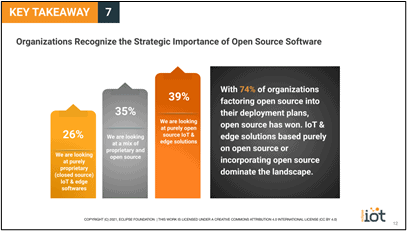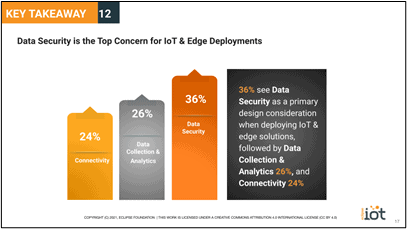
The IoT and Edge Computing market is growing, and the Eclipse IoT & Edge Native working groups offer a mature and growing open source ecosystem upon which to build and deploy applications.
By way of full disclosure, I work for an open source foundation. While this may result in some bias on the topic, it also puts me in a great position to share what I know and learn about industrial open source ecosystems. My purpose in writing this article is to do exactly that — to share what I consider to be important and timely information about the commercial adoption of open source IoT and Edge Computing technologies.
The IoT working group and Edge Native working group at the Eclipse Foundation recently published the results of our 2021 IoT & Edge Commercial Adoption Survey. Needless to say, there are some intriguing findings in the report to go along with insightful recommendations for various IoT and Edge Computing industry stakeholders. Here’s a sampling of those recommendations:
- If you work for an organization currently deploying IoT and Edge Computing solutions, you should select vendors and service providers that embrace open standards and leverage production-grade and commercial quality open source building blocks.
- If you work for an organization currently deploying IoT and Edge Computing solutions, you should select vendors and service providers that embrace open standards and leverage production-grade and commercial quality open source building blocks.
- If you work for an organization currently deploying IoT and Edge Computing solutions, you should select vendors and service providers that embrace open standards and leverage production-grade and commercial quality open source building blocks.
The report contains a lot more great data and recommendations, and I would encourage you to read it yourself in order to draw your own conclusions. From my viewpoint, the trend is clear: regardless of whether you are deploying, integrating, or supplying products for IoT and the Edge, open source is critical to your success.
Why Innovators and Industry Leaders Use Open Source
In reviewing the survey results, we can clearly see that open source is a critical building block for IoT and Edge applications. Nearly 40% of survey respondents are using or evaluating the use of open source solutions exclusively, while another 35% are looking at a mix of open source and proprietary components.

To further validate and better understand the underlying dynamics, respondents were asked to identify the number one reason for building on open source. Since open source software is generally available for free, you may expect cost advantage to be at the top of the list. However, only 18% of respondents selected cost as the primary decision factor. Rather, at 29%, the ability to influence and customize code was at the top of the list. An additional 14% said flexibility was the top reason for using open source.
Considering the specificities of IoT and Edge applications, these results actually make perfect sense. Such solutions are often deployed in remote or hard-to-reach places, needing to take into account strict constraints for power consumption, bandwidth usage, environmental, and other factors. Moreover, the hardware platforms offer limited processing, storage, and memory capacities to fit within these constraints as well as to keep costs under control. All this considered, it is not surprising that IoT and Edge practitioners like open source as it simply meets their need for customization.
An important, yet often overlooked, aspect of open source projects is that they all owe their existence to communities of developers. Since the code is built in a collaborative fashion, it is much easier for adopters to get answers to their questions and propose new features. Getting that level of engagement from a proprietary software vendor is completely unrealistic and would be very rare.
IoT and Edge Adoption is Growing
Another clear takeaway from the survey is that IoT and Edge adoption is poised for explosive growth. 47% of respondents are already deploying IoT solutions, while 39% are planning to do so in the next 24 months. For Edge Computing, 38% of respondents are deploying today, with an additional 46% deploying within the next 24 months. This points to a significant number of deployments being beyond the proof-of-concept stage and needing to integrate with existing processes and devices, naturally making projects more complex and extending deployment timeframes.
The survey also found solid growth in planned investments for IoT and Edge projects. The percentage of respondents planning to spend between $100K and $1M USD on their projects rose from 15% in 2019 to 30% in 2021. There was also noticeable growth in projects over $1M, from 12% in 2019 to 16% in 2021. It’s fair to say there are plenty of business opportunities in the IoT and Edge markets. However, just to reiterate what has already been discussed, solution providers and platform vendors should focus on value-added features on top of a proven open source foundation rather than attempt to implement their own components and platforms.
Deployment Challenges and Concerns
While IoT and Edge Computing deployments are on the rise, current and potential adopters do have specific concerns and challenges to address.

Unsurprisingly, data security is the top concern for 36% of survey respondents. For this reason, solution providers must implement robust encryption for data at rest, religiously use the security features offered by common IoT protocols, and leverage technologies that make it easier to ensure data sovereignty. At 26%, data collection and analytics is intimately linked to security. Ecosystem players must ensure they have proper data collection policies in place, and that their approach to analytics does not inject bias. Finally, 24% of respondents identified connectivity as their top concern. With such a broad variety of options currently available, it is sometimes difficult to pick the most appropriate and cost-effective solution for a specific application or deployment. However, connectivity stacks built around an open source foundation contribute to flexibility, interoperability, and cost reduction.
IoT and Edge: Already Here, and Here to Stay
While there is a lot more to be gleaned from the 2021 IoT and Edge Commercial Adoption Report, my hope is that this overview of a few of the takeaways has been insightful and will make you want to learn more. The bottom line is that IoT and Edge Computing are here to stay. The market is growing, and the Eclipse IoT & Edge Native working groups offer you a mature and growing open source ecosystem upon which to build and deploy your applications.
I invite you to download the report for additional insights, recommendations, and analysis. Also, stay tuned for our annual IoT and Edge developer survey coming up in the fall of 2021.




























